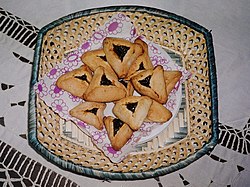Italian Hamantaschen-Orecchie di Haman
As promised, i found a recipe for the Italian version of the traditional Purim dessert: Orecchie di Haman.
First difference with the Ashkenazi Hamantaschen is in the name itself: Orecchie di Haman means "Haman's Ears", while Hamantaschen means "Haman's Pockets".
Secondly, the Italian version is deep fried and it doesn't have a filling.
Here is the recipe, courtesy of Chabad.org:
ingredients:
4 eggs
60 gr. sugar
4 tablespoons of wine
4 tablespoons of oil
salt
flour (as needed)
Mix ingredients well and make a dough soft and smooth. Roll out the dough with a rolling pin but do not make it too thin. Cut the dough into strips and rectangles and fry immediately in hot oil.
Allow to cool and dissolve in the meantime in a saucepan half a kg of sugar and half a glass of water. Boil for 5 minutes and soak the ears for a few moments. Remove and serve directly.
And here i found a very interesting article about Hamantaschen on Wikipedia:
Hamantash
From Wikipedia, the free encyclopedia

 Homemade prune hamantashen
Homemade prune hamantashen
A hamantash (also spelled hamentasch, homentash, homentasch, (h)umentash, pluralized with -en or -n {sometimes singular is spelled this way also}; Yiddish המן־טאַש) is a pastry in Ashkenazi Jewish cuisine recognizable for its three-cornered shape. The shape is achieved by folding in the sides of a circular piece of dough, with a filling placed in the center. It is traditionally eaten during the Jewish holiday of Purim. While occasionally seen other times of year in secular contexts, this is not traditional. Hamantashen are made with many different fillings, including poppy seed (the oldest and most traditional variety),[1] prunes, nut, date, apricot, apple, fruit preserves, cherry, chocolate, dulce de leche, halva, or even caramel or cheese.[2] Their formation varies from hard pastry to soft doughy casings.
The name hamantash (המן־טאַש), is commonly known as a reference to Haman, the villain of Purim, as described in the Book of Esther. The pastries are supposed to symbolize the defeated enemy of the Jewish people, and thus resemble the "ears of Haman".[3] “Naked Archaeologist” documentarianSimcha Jacobovici has shown the resemblance of hamantaschen to dice from the ancient Babylonian Royal Game of Ur, thus suggesting that the pastries are meant to symbolize the pyramidal shape of the dice cast by Haman in determining the day of destruction for the Jews.[4] Another possible source of the name is a folk etymology: the original Yiddish word מאָן־טאַשן (montashn) or German word mohntaschen, both meaning poppyseed-filled pouches,[5] was transformed to Hamantaschen, likely by association with Haman. In Israel, they are called Oznei Haman (Hebrew: אוזני המן), Hebrew for "Haman's ears" in reference to their defeated enemy's ears. Another folk story is that Haman wore a three-cornered hat ---thus the shape. Hamantashen can cause drug tests for opiates to show up positive if eaten in large amounts due to the amount of poppy seeds in them.
First difference with the Ashkenazi Hamantaschen is in the name itself: Orecchie di Haman means "Haman's Ears", while Hamantaschen means "Haman's Pockets".
Secondly, the Italian version is deep fried and it doesn't have a filling.
Here is the recipe, courtesy of Chabad.org:
ingredients:
4 eggs
60 gr. sugar
4 tablespoons of wine
4 tablespoons of oil
salt
flour (as needed)
Mix ingredients well and make a dough soft and smooth. Roll out the dough with a rolling pin but do not make it too thin. Cut the dough into strips and rectangles and fry immediately in hot oil.
Allow to cool and dissolve in the meantime in a saucepan half a kg of sugar and half a glass of water. Boil for 5 minutes and soak the ears for a few moments. Remove and serve directly.
And here i found a very interesting article about Hamantaschen on Wikipedia:
Hamantash
From Wikipedia, the free encyclopedia

 Homemade prune hamantashen
Homemade prune hamantashenA hamantash (also spelled hamentasch, homentash, homentasch, (h)umentash, pluralized with -en or -n {sometimes singular is spelled this way also}; Yiddish המן־טאַש) is a pastry in Ashkenazi Jewish cuisine recognizable for its three-cornered shape. The shape is achieved by folding in the sides of a circular piece of dough, with a filling placed in the center. It is traditionally eaten during the Jewish holiday of Purim. While occasionally seen other times of year in secular contexts, this is not traditional. Hamantashen are made with many different fillings, including poppy seed (the oldest and most traditional variety),[1] prunes, nut, date, apricot, apple, fruit preserves, cherry, chocolate, dulce de leche, halva, or even caramel or cheese.[2] Their formation varies from hard pastry to soft doughy casings.
The name hamantash (המן־טאַש), is commonly known as a reference to Haman, the villain of Purim, as described in the Book of Esther. The pastries are supposed to symbolize the defeated enemy of the Jewish people, and thus resemble the "ears of Haman".[3] “Naked Archaeologist” documentarianSimcha Jacobovici has shown the resemblance of hamantaschen to dice from the ancient Babylonian Royal Game of Ur, thus suggesting that the pastries are meant to symbolize the pyramidal shape of the dice cast by Haman in determining the day of destruction for the Jews.[4] Another possible source of the name is a folk etymology: the original Yiddish word מאָן־טאַשן (montashn) or German word mohntaschen, both meaning poppyseed-filled pouches,[5] was transformed to Hamantaschen, likely by association with Haman. In Israel, they are called Oznei Haman (Hebrew: אוזני המן), Hebrew for "Haman's ears" in reference to their defeated enemy's ears. Another folk story is that Haman wore a three-cornered hat ---thus the shape. Hamantashen can cause drug tests for opiates to show up positive if eaten in large amounts due to the amount of poppy seeds in them.


Comments
Post a Comment